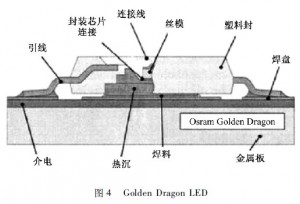Recently, LED scientists have invented a new packaging structure for super high power LED lights: silicon based chips. Normal LED chip has a layer of epoxy resin on the top and use sapphire as base. Both of them are weak in thermal conductivity. Therefore, heat can only be transmitted though pins. It is very hard for heat to be radiated from both side (up and down), impacting a bad effect on chips function and reliabilities. In 2001, LumiLeds invented a new LED package structure: AlGalnN structure. It is a typical silicon based structure,. LED chips will be mounted on silicon bases though small bumps. Thus heat can be directly transmitted into silicon/ceramic bases, which obviously have larger thermal conductivities, and consequently into external metal bases. However, thermal resistance is proportional to the thickness of heat sinks. Due to the restrictions from the mechanical strength of silicon, it is very hard to further reduce the thermal resistance (increase the thermal conductivity) by reducing the thickness of silicon bases.

How PCB materials affect the cooling section of super high power LED lights?
In the process of thermal transmission from LED chips into circuit boards, the thermal conducting capacity of PCBs is rather important. At the same time, PCBs also provides electrical connection and physical support for LED chips. Thus, the designs for PCBs must take both electrical capacity and thermal conductivity into account.
Materials for high power PCBs must have high-insulation resistors, high reliabilities, high conductivities, a CET (coefficient of thermal expansion) which is quite similar to LED chips. With so many restrictions, only few metals or alloys can meet the requests. In order to guarantee the insulation, the entire PCB needs to be coated with a layer of MIP (Molecularly Imprinted Polymer) membrane or ceramic membrane.
Currently, most LED CHINA manufacturers would like to use MCPCB structures: connect chips with PCBs (with a layer of copper electrode on surface) though aluminum due to its good thermal conducting capacity. Another way is connecting LED chips on PCBs which have metal sandwiches, then mounting the them on cooling sections. Norlux series made by UOE are LED chips using such package technique. UOE’s designers connected LED chips on PCBs which contain a very thin aluminum layer (shows as follow). PCB plays a role of electronic connection of LED High Bay chips and the aluminum layer works as a heat radiator.
